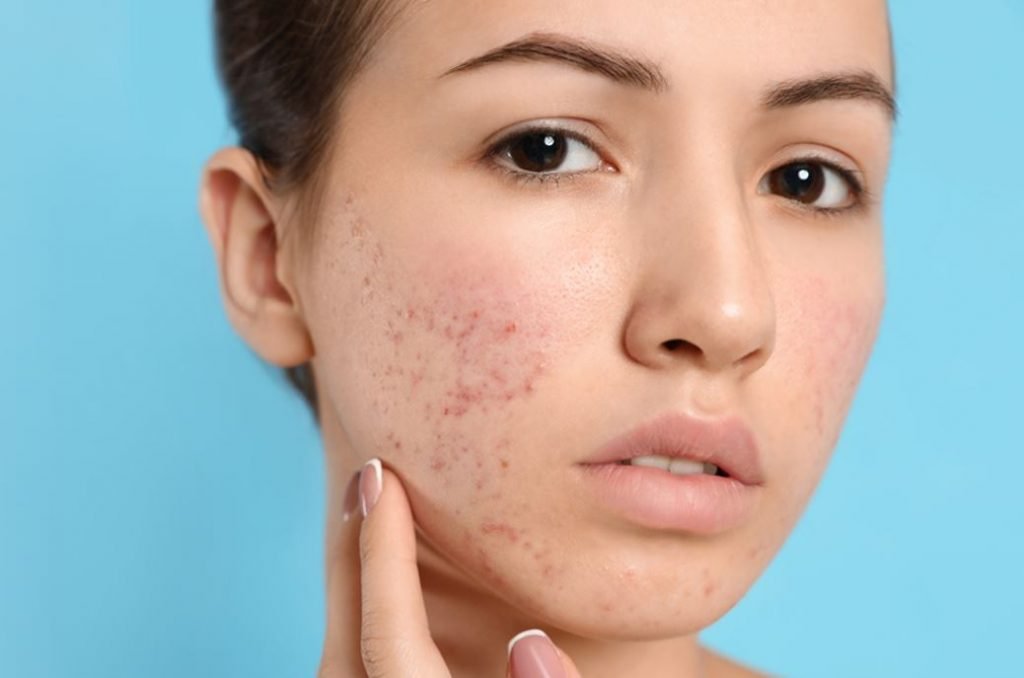ACNE SCARS
Acne scars are a common skin concern that can develop as a result of severe or persistent acne. These scars can vary in appearance and severity, and they often affect a person’s self-esteem and confidence. There are different types of acne scars, and the most common ones include:

- Atrophic or Depressed Scars: These scars appear as indentations in the skin and are further divided into three subtypes:
- Ice Pick Scars: Narrow, deep, and sharply defined pits in the skin.
- Boxcar Scars: Wider and more rectangular depressions with defined edges.
- Rolling Scars: These scars have a wavy or undulating appearance and can be shallow or deep.
- Hypertrophic or Keloid Scars: These scars are raised above the skin’s surface and can be red or pink in color. They result from an overproduction of collagen during the healing process.
- Post-Inflammatory Hyperpigmentation (PIH): While not a true scar, PIH can occur after an acne lesion has healed. It presents as dark spots or patches on the skin and is more common in people with darker skin tones.
To address acne scars, several treatment options are available, depending on the type and severity of the scarring:
- Topical Treatments: Over-the-counter or prescription creams and gels containing ingredients like retinoids, alpha hydroxy acids, or silicone may help improve the appearance of mild acne scars.
- Chemical Peels: Chemical peels involve applying a chemical solution to the skin, which removes the top layer and encourages the growth of new, smoother skin.
- Microdermabrasion: This procedure exfoliates the skin’s surface using a machine with a rotating abrasive applicator to reduce the appearance of superficial scars.
- Microneedling: Microneedling involves using a device with tiny needles to create controlled micro-injuries in the skin, promoting collagen production and improving the texture of the skin.
- Laser Therapy: Various laser treatments, such as fractional laser therapy and ablative laser resurfacing, can help reduce the appearance of acne scars by stimulating collagen production and removing damaged skin layers.
- Dermal Fillers: Injectable fillers can be used to temporarily raise and fill in depressed scars, providing a smoother skin surface.
- Steroid Injections: For raised keloid or hypertrophic scars, corticosteroid injections may be used to flatten and soften the scar tissue.
- Surgical Procedures: In some cases, more invasive procedures like punch excisions, subcision, or surgical scar revision may be necessary to treat certain types of acne scars.
It’s important to consult with a dermatologist or skincare professional to determine the best treatment plan for your specific acne scars. Treatment efficacy can vary depending on factors such as scar type, skin type, and individual response to therapy. Additionally, it’s crucial to follow proper skincare routines and sun protection measures to prevent further scarring and protect the healing skin.
Homeopathic treatment
So what homeopathic medicines are available to treat asthma? Asthma like any other condition can be treated with homeopathy at various levels. The ideal would be to find the treatment, which reflects the Similimum of the case (or as near to the Similimum as possible). By Similimum, I mean the remedy that best matches the person not just in terms of his symptoms but also in terms of his psyche and the way that he relates to other people and to life generally. This would offer a deeper prospect of healing. However finding the Similimum may not always be possible and there are many remedies which may be given for the symptoms of asthma. There are also remedies that can be given for the causes of allergic asthma (homeopathic preparations of house dust mite, grasses and pollens etc). Asthma is a condition for which I would highly recommend professional treatment – I would not advocate self-treatment. Here are the outlines of a few remedies, which may be helpful in the treatment of asthma
